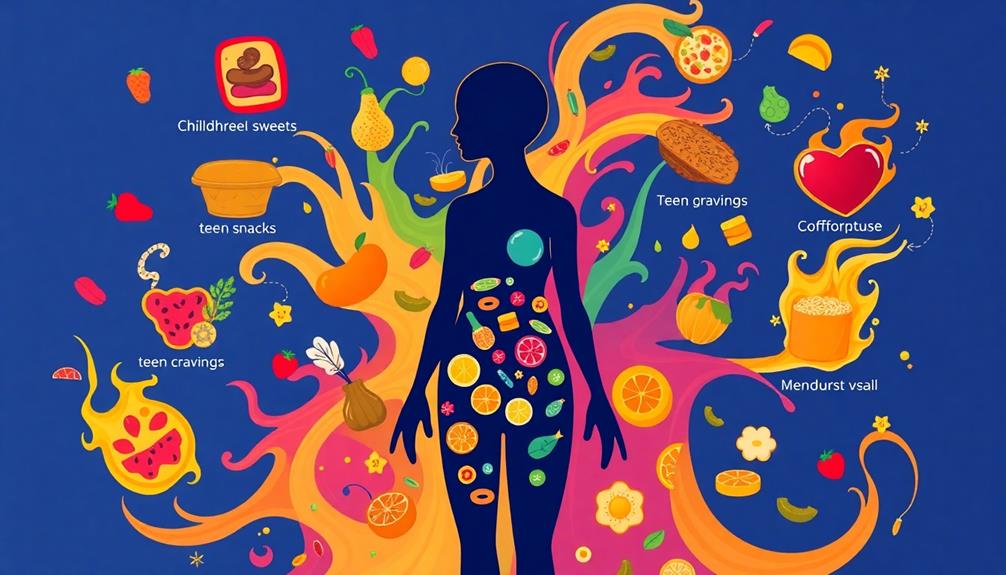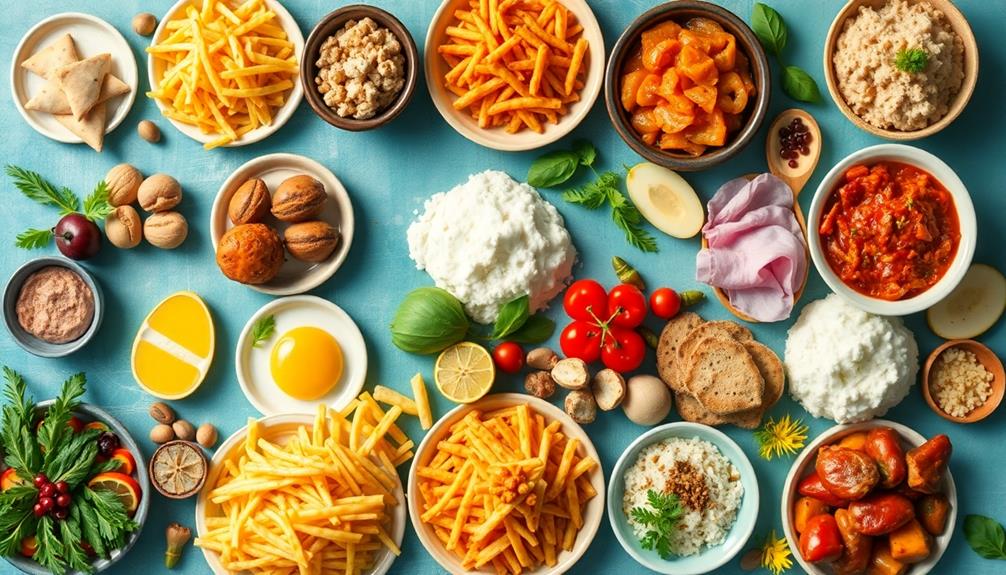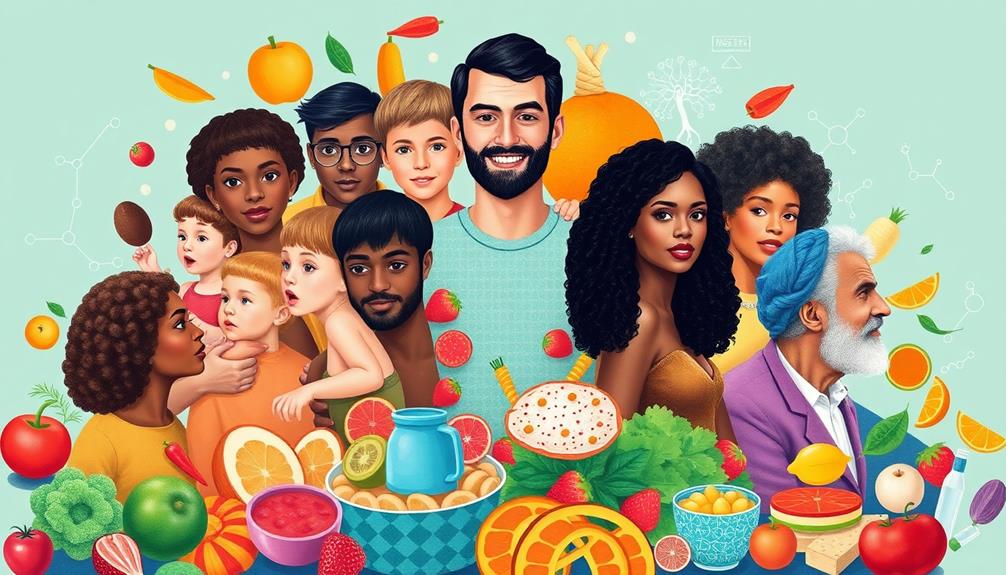Food cravings change throughout your life, often driven by hormonal shifts, psychological states, and environmental cues. During certain life stages, like the menstrual cycle or pregnancy, hormonal fluctuations can intensify cravings for specific foods. As you age, your metabolism slows, leading to altered eating habits and preferences. Emotional factors, such as stress, can also trigger cravings for comfort foods. You might find that cultural influences shape your desires, too. Understanding these aspects helps you manage cravings better. If you're curious about how to navigate these cravings effectively, there's much more to explore.
Key Takeaways
- Hormonal fluctuations during the menstrual cycle and pregnancy significantly influence food cravings, often leading to increased desires for sweets and carbohydrates.
- Aging reduces metabolic rate, resulting in fewer cravings and altered eating behaviors, complicating weight management for older adults.
- Emotional states, particularly stress, are strong triggers for cravings, often steering individuals towards high-calorie comfort foods.
- Cultural influences shape food cravings, with gender disparities evident as women typically crave sweets, while men prefer savory options.
- Mindfulness techniques, such as meditation and mindful eating, can help manage cravings by fostering awareness of emotional triggers and distinguishing true hunger.
Overview of Food Cravings

Food cravings are powerful urges for specific foods that can hit you at any time, often without any physical hunger. These cravings can stem from various factors, including hormonal fluctuations during different life stages, such as the menstrual cycle or pregnancy. You might notice that your cravings intensify during these times, driven by hormonal changes.
For example, during certain periods, you may find yourself craving comforting dishes like Red-Braised Pork Belly, which is known for its rich flavor and tender texture.
Emotional triggers also play a significant role in your eating behavior. If you're experiencing chronic stress, you may find yourself gravitating toward comfort foods, which can lead to a higher body mass index over time.
Additionally, your gut microbiome influences your cravings, suggesting that what you eat can affect your dietary preferences and desires. Sometimes, nutrient deficiencies can provoke cravings as your body signals a need for specific nutrients.
To manage these intense urges, mindfulness-based interventions, like meditation and deep breathing, can be effective. By practicing mindfulness, you can better recognize emotional triggers and develop healthier responses to cravings.
Understanding the complexities behind food cravings helps you navigate your eating behavior during various life stages, empowering you to make more informed choices.
Hormonal Influences on Cravings

During different life stages, hormonal influences can greatly shape your food cravings. For instance, during the menstrual cycle, hormonal fluctuations, especially in the luteal phase when progesterone peaks, can trigger intense food cravings. You might find yourself craving sweets and high-calorie foods as your appetite increases due to these changes.
After a big meal, such as a Thanksgiving feast, many people seek comfort in turkey sandwiches or other familiar leftovers, which can also be linked to these hormonal shifts.
Pregnancy introduces another layer, activating dopaminergic circuits in your brain that heighten cravings for specific foods. This often stems from your body's increased nutritional needs for fetal development. Hormones like leptin and ghrelin play a critical role here, regulating hunger and satiety. However, during times of hormonal change, their balance can become disrupted, leading to altered eating behaviors.
Additionally, if you experience premenstrual syndrome (PMS), you may notice intensified cravings for carbohydrates and sweets, correlating with mood shifts and appetite changes tied to hormonal fluctuations.
Even sleep deprivation can impact your hormonal balance, resulting in stronger cravings for high-fat and high-sugar foods. Understanding these hormonal influences can help you better manage your cravings and nutritional needs throughout different life stages.
Age-Related Changes in Eating

As you age, your body undergoes various changes that can impact your eating habits and cravings. One significant factor is the decline in metabolic rate, leading to decreased food cravings and altered eating behaviors, especially among older adults. This shift can pose challenges for weight management, as appetite regulation becomes less effective with age.
You might find your favorite meals less enticing, such as the vibrant flavors of Mushroom Masala, which may have once been a go-to dish. Cravings that once drove you to indulge may fade away. The struggle against weight gain can feel more intimidating.
Age-related changes also reveal intriguing psychological aspects. Younger individuals often exhibit cognitive restraint, which reduces cravings, while older adults frequently experience diminished cravings linked to hormonal fluctuations.
Gender differences persist too—women tend to crave sweets, while men often prefer savory foods, regardless of age.
These factors contribute to the rising prevalence of obesity, with 39% of adults categorized as overweight globally. Understanding how age influences your cravings and eating behaviors can empower you to make healthier choices and navigate the complexities of appetite regulation effectively.
Psychological Factors Affecting Cravings

Understanding your cravings goes beyond age-related changes in metabolism; psychological factors play a significant role. Your emotional states heavily influence food cravings, with stress often pushing you toward high-calorie comfort foods.
For instance, during periods of emotional stress, you may find yourself yearning for dishes like Nettle and Potato Soup, which provide warmth and comfort. Chronic stress can lead to impulsivity, making it harder to resist those cravings. Additionally, hormonal fluctuations, especially during the menstrual cycle, can intensify cravings as mood and emotional well-being shift.
Environmental cues also trigger cravings, reminding you of certain foods through learned behaviors. For instance, walking past a bakery might spark a sudden desire for sweets. This connection is rooted in your experiences and can be challenging to break.
Mindfulness can be a powerful tool in managing cravings. By practicing mindfulness, you can better identify emotional triggers and differentiate between genuine hunger and cravings driven by stress or habit.
This awareness allows you to adjust your eating patterns and develop healthier responses to cravings. Overall, understanding how psychological factors intertwine with your food cravings can empower you to make more informed choices and foster a healthier relationship with food.
Cultural Differences in Food Desires

When you think about food cravings, it's fascinating how they vary across cultures. In some places, you might crave rice or sushi, while in others, you lean towards savory or sweet dishes based on gender.
For instance, traditional Japanese sweets like Dorayaki (Red Bean Pancake) may evoke a sense of nostalgia and comfort.
These cravings not only reflect local traditions but also highlight how your age and cultural background shape your food desires.
Global Craving Variations
Across the globe, food cravings reveal a fascinating tapestry of cultural influences that shape our desires. You might notice how regional dietary preferences, like a love for rice in Japan or sushi among Japanese females, reflect deeper cultural roots.
In Brazil, for instance, the rich flavors of traditional dishes such as Caldeirada and sweet treats like Brigadeiro exemplify how cultural heritage influences food cravings. These cravings aren't solely biological; they're also shaped by environmental factors and marketing strategies.
- The enticing aroma of street food can spark cravings for savory delights.
- Sweet foods often hold nostalgic value, tying you to cherished memories.
- Age and lifestyle factors play a role, as younger adults might crave different foods than older generations.
Cultural differences and learned behaviors can condition your food desires. Studies show that gender disparities exist, with females often craving sweets more than males, who lean toward savory foods.
This dynamic showcases the interaction between cultural influences and biological tendencies. Additionally, aggressive advertising can exacerbate cravings for unhealthy foods within specific populations.
Understanding these global craving variations can help you navigate your own food desires, offering insight into how your cravings connect to broader cultural narratives.
Gender-Specific Craving Trends
Food cravings often highlight distinct gender-specific trends influenced by cultural backgrounds and biological factors. Research shows that women generally crave sweet foods, especially during hormonal fluctuations in the menstrual cycle. In the luteal phase, many women experience increased cravings for carbohydrates and high-calorie options. This can be seen in cravings for comforting foods, such as Chilaquiles, which are often enjoyed for their rich flavors and satisfying textures.
In contrast, men tend to favor savory foods, often driven by physiological hunger rather than emotional states. Cultural influences also play a significant role in shaping these cravings. For instance, in Japan, rice is a common craving, reflecting the region's dietary norms.
Age-related differences further complicate these trends; younger women may feel cravings more intensely during hormonal changes, while older women often notice a decrease in cravings as they age. Moreover, studies indicate that women's cravings are closely linked to emotional states, such as stress or mood swings, unlike men, whose cravings are more associated with their physiological hunger.
Understanding these gender differences in food cravings can help you navigate your desires more effectively and make informed choices about your diet throughout different life stages.
Strategies for Managing Cravings

When cravings hit, you can use mindfulness techniques to better understand their roots and manage them effectively.
Incorporating classic Southern comfort foods, like satisfying squash casserole, can provide a nourishing option that curbs cravings while celebrating flavor.
Balancing your meals and snacks helps maintain steady energy levels, reducing those intense urges.
Plus, being mindful of your environment can help you steer clear of triggers that lead to unhealthy choices.
Mindfulness Techniques
Mindfulness techniques offer powerful strategies for managing cravings effectively. By incorporating mindfulness practices into your daily routine, you can increase your awareness of emotional triggers and gain control over eating behaviors.
Exploring the rich flavors of dishes like Ethiopian salad can be an enjoyable way to focus on fresh ingredients while practicing mindful eating. Just 5-7 minutes of meditation or deep breathing can help you recognize the difference between emotional responses and actual hunger, reducing cravings considerably.
- Feel the satisfaction of savoring each bite instead of rushing through meals.
- Experience the freedom of not letting stress dictate your eating habits.
- Build healthier relationships with food that nourish your body and mind.
Mindful eating encourages you to truly enjoy your meals, enhancing satisfaction and decreasing the likelihood of overeating. This practice helps you cultivate self-regulation, making it easier to resist unhealthy cravings.
Mindfulness-based interventions are especially beneficial for individuals grappling with cravings linked to stress or emotional distress, providing effective coping tools without turning to food. By embracing mindfulness, you can transform your relationship with food, allowing you to manage cravings in a positive, empowering way.
Ultimately, these techniques pave the way for a healthier lifestyle and greater peace of mind.
Nutritional Balance
Achieving nutritional balance is essential for effectively managing cravings throughout different life stages. By focusing on a diet rich in protein and fiber, you can promote longer-lasting satisfaction and stabilize your blood sugar levels. Incorporating traditional dishes like Nasi Tumpeng can add variety while ensuring you're surrounded by nutritious side dishes.
Regular meals and snacks every 3-4 hours help prevent extreme hunger, reducing the likelihood of intense cravings for unhealthy foods. Hydration plays a key role too; drinking water, tea, or coffee with minimal sugar can help mitigate cravings, as dehydration is often mistaken for hunger.
Incorporating a variety of colorful fruits and vegetables into your daily meals not only provides essential nutrients but also lessens the desire for hyperpalatable, ultra-processed snacks.
Mindful eating practices are invaluable. Pay attention to your emotional triggers and eat slowly to better recognize and manage cravings. This approach allows you to tune into your body's signals, helping you distinguish between true hunger and emotional eating.
Environmental Cues
Environmental cues can powerfully influence your cravings, often leading to unhealthy eating habits. From food advertising to the mere presence of hyperpalatable foods, these triggers can escalate cravings intensity and increase your calorie intake.
To combat this, consider implementing strategies that reduce your exposure to these cues.
- Avoid aisles filled with unhealthy snacks during grocery trips.
- Practice mindfulness to recognize and unlearn associations between specific environments and your cravings.
- Engage in distractions like walking or reading when cravings strike.
Creating a supportive environment is essential. Stock your pantry with healthy snacks and minimize the availability of unhealthy options.
This simple change can greatly promote better eating habits and help you manage cravings more effectively. By being aware of environmental cues and proactively addressing them, you can take control of your food cravings and foster a healthier lifestyle.
Recent Research Insights

Recent research has shed light on the complex factors influencing food cravings throughout various life stages. For women, hormonal fluctuations during the menstrual cycle play a vital role, with cravings typically peaking during the luteal phase. This insight emphasizes how your body's natural rhythms can impact what you crave.
Age-related changes also affect food cravings; younger individuals often show cognitive restraint, leading to decreased cravings, while older adults tend to experience an overall reduction in cravings.
Additionally, sleep deprivation heightens cravings for high-calorie foods, disrupting energy balance and increasing the risk of obesity.
Moreover, genetic interactions come into play; studies on the FTO gene indicate that certain genotypes may correlate with a higher body mass index (BMI) without greatly altering eating behavior or food cravings. This highlights the complexity of how genetics can influence your relationship with food.
Frequently Asked Questions
What Is the Science Behind Food Cravings?
Food cravings arise from complex interactions between your brain, hormones, and emotions. They can be triggered by stress, environmental cues, or even memories, influencing your dietary choices and overall well-being without always reflecting actual hunger.
What Is the Biological Cause of Food Cravings?
Did you know that nearly 90% of people experience food cravings? These cravings stem from hormonal fluctuations, brain reward responses, and conditioned associations, driving your desire for specific foods, especially when you're stressed or tired.
What Is the Evolutionary Significance to Hunger and Cravings?
Hunger and cravings evolved as survival mechanisms, signaling your body's need for energy and nutrients. They drive you to seek high-calorie foods, ensuring you thrive even during times of scarcity in your environment.
What Are Your Food Cravings Telling You?
Your food cravings often signal underlying needs. They could reflect nutrient deficiencies, emotional states, or hormonal changes. Listening to these cravings helps you understand your body better and make more informed dietary choices.
Conclusion
In understanding food cravings, you can navigate your nutritional needs with newfound knowledge. By recognizing the hormonal highs and psychological pulls that play a part in your appetite, you can make mindful choices. Embracing the ebb and flow of cravings throughout life stages empowers you to eat intentionally. So, savor the science behind your desires, and steer your selections wisely. With these strategies, you'll transform tempting treats into balanced bites that nourish both body and mind.









